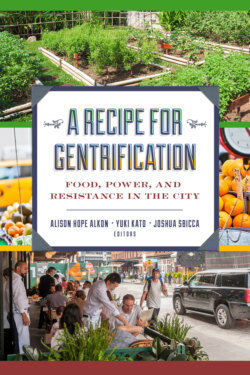Читать книгу A Recipe for Gentrification - Группа авторов - Страница 16
Conclusion
ОглавлениеFood has become a central element of the transformation of urban areas in San Diego and elsewhere, simultaneously reflecting and promoting gentrification. The examples of North Park and Barrio Logan illustrate that gentrification has a unique taste: a combination of cosmopolitanism, authenticity, democracy, and ethical consumerism that builds on existing assets for the benefits of new residents who use these attributes to set themselves apart from previous dwellers. These contemporary narratives of “good taste” are associated with particular food practices that are inherently connected to places but at the same time deny parts of their social histories. The ethnic and urban aesthetic of popular restaurants is an essential element of the geographic imaginary surrounding good taste and a key mechanism for pushing the gentrification frontier and assigning value to previously neglected urban areas. As older food outlets are replaced by expensive new eateries, the resulting discursive foodscape no longer reflects the lifestyle of longtime residents who feel increasingly excluded by the symbolic boundaries it creates (Joassart-Marcelli and Bosco 2020). In addition to the rising cost of purchasing food, residents feel out of place in many of the new shops and restaurants where the food, music, drinks, décor, and customers’ behavior reflect whiteness and class privilege. The displacement of classed and racialized residents in places that claim to be multicultural and authentic is poignantly illustrated in this Yelp post about a new Barrio Logan eatery:
The last time I came to this place I was extremely disappointed with the service I received […] I don’t know what’s worse: getting treated like shit by sorry to say it but white people who see nothing but a dark colored man in construction clothes or getting treated like shit in your own neighborhood by your own people who see nothing but a dark guy in construction clothes. The whole experience made me really upset and sad.
The “good taste” narratives that reify ethnic and working-class foods and commodify the neighborhoods where such foods have been historically prepared and consumed—albeit in different ways—are not produced in a vacuum. Neither are they simply the reflection of changing consumer preferences. As Zukin et al. (2009) argue, gentrification is a cultural process that is shaped by powerful actors. In our study neighborhoods, these actors include the restaurant industry, developers, neighborhood organizations, and local governments, who benefit from creating foodscapes that are perceived as authentic and cosmopolitan. For instance, in our two study areas, events such as the Taste of North Park, Ray at Night, or the Barrio Art Crawl are organized by neighborhood business associations to encourage visitors to come and explore art and food. The City of San Diego is also actively using food as a way to draw people to these neighborhoods through various sponsored events and publications praising Barrio Logan’s “authentic culinary delights” (San Diego Tourism Authority 2018) and describing North Park as a “true food lover’s sanctuary, for every craving and every taste bud” (Explore North Park 2018). San Diego Magazine, which publishes extensive restaurant reviews and annual “best of” lists, is primarily funded by advertising from local businesses, including restaurants as well as real estate and construction companies that may have common interests in the gentrification of neighborhoods around downtown San Diego.
To resist food gentrification, therefore, we must contend with these popular narratives that mask social exclusion under the guise of authenticity, cosmopolitanism, and democratic values. In doing so, we must consider the various actors involved in producing the taste of gentrification and the motives behind their efforts. More research on the urban politics of food retail will help bridge the gap between cultural and political-economic explanations of gentrification and identify avenues for resisting social exclusion and spatial displacement.
